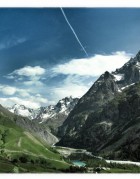
Crude Oil Crashes
Production from Unconventional US oilfields such as the Bakken continues to increase (http://www.eia.gov/todayinenergy/detail.cfm?id=13811#) with the Bakken shale soon to join the Eagle Ford shale in the 1 million barrels a day production club. That’s up from 200,000 barrels per day in 2009, and makes it one of the top five or so “fields” in the world by production.
Firms are clearly mastering the best technologies to get the oil out of the ground. The tricky bit is proving to be shipping and selling the stuff. The pipeline system is bottle necked and simply can’t handle the volume. So the oil out of those high-tech fracking wells goes into a low tech transport solution – trains.
Rail freight continues to grow with production. In 2009 Canadian Pacific moved just 500 carloads of crude oil. In 2011 they shipped 13,000 carloads. In 2012 it shipped 53,000 carloads. That’s about 34 million barrels of oil, or around 100,000 barrels per day. The firm is guiding for around 210,000 car loads in 2016.
Unfortunately, there have been a series of accidents.
The latest accident occurred in northwest New Brunswick, near Plaster Rock in the Canadian Maritimes, on Tuesday 7th January. A 122 car Canadian National train derailed on the way to the Irving refinery at Saint John. That’s the same refinery that was the destination for the crude in the Lac Megantic disaster in July last year. Forty seven people died in the Lac Megantic crash, and more than 30 buildings were destroyed in a 1km blast radius (http://en.wikipedia.org/wiki/Lac-M%C3%A9gantic_derailment). Thankfully, whilst 45 homes were evacuated and a two km no-go zone was created, no one was hurt in the recent incident.
But the incidents keep on happening.
Just before Christmas 2012 there was another derailment of a crude train near Casselton, North Dakota. This time the train was owned by Burlington Northern Santa Fe. The explosions sent 100 foot flames into the sky (http://www.youtube.com/watch?v=CxkUhVswF5U ; https://twitter.com/KyleJohnsonVNL/status/417842145119068161/photo/1).
In November 2012 a 90-car oil train bound for a Shell Chemicals plant near Mobile, derailed & exploded in Pickens County, Alabama.
In October 2012 a Canadian National train carrying LPG derailed and exploded west of Edmonton, Alberta. Flames from the explosion shot across the Yellowhead Highway (http://www.theguardian.com/world/2013/oct/19/canada-rail-fire-derailment).
Spot the trend?
These things are happening regularly. And when they do, investigators often find that the crude is mis-classified as a less dangerous type, or that the train-cars are old and have design flaws.
It’s a gold rush. Production from the Bakken continues to grow at ears-back pace. And like any gold rush, people are cutting corners to make a profit. There will be more derailments.
Do you live near a rail line?
http://crudeoilpeak.info/wp-content/uploads/2013/07/North_Dakota_crude_oil_loading_facilities.jpg

Crude oil rail routes
https://www.aar.org/keyissues/Documents/Background-Papers/Crude-oil-by-rail.pdf

Reblogged this on Gates Goes Down and commented:
U.S. Oilrush Ranks Greed Over Life